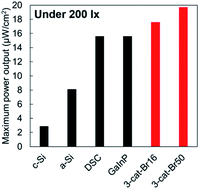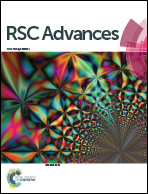Segregation-free bromine-doped perovskite solar cells for IoT applications†
Abstract
Perovskite solar cells have attracted much attention as next-generation solar cells because of their high efficiency and low fabrication costs. Moreover, perovskite solar cells are a promising candidate for indoor energy harvesting. We investigated the effect of bandgap tuning on the characteristics of triple cation-based perovskite solar cells under fluorescent lamp illumination. According to the current density–voltage curves, perovskite solar cells with a wider bandgap than the conventional one exhibited improved open-circuit voltage without sacrificing short-circuit current density under fluorescent lamp illumination. Moreover, the wider bandgap perovskite films including a large amount of bromine in the composition did not show phase segregation, which can degrade the photovoltaic performance of perovskite solar cells, after fluorescent lamp illumination. Our results demonstrate the facile strategy to improve the performance of perovskite solar cells under ambient lighting and great potential of perovskite solar cells for indoor applications such as power sources for the internet of things.



 Please wait while we load your content...
Please wait while we load your content...